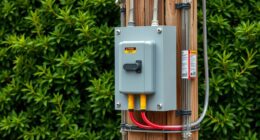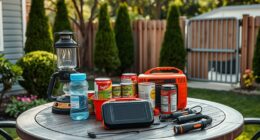If you want to keep your generator running smoothly, I recommend exploring the top remote monitoring systems that offer real-time data, alerts, and easy control options. From Wi-Fi-enabled units like Generac Guardian to wireless remote start models from Champion and Westinghouse, there are plenty of reliable choices. These systems help you stay on top of performance and maintenance, reducing downtime. Stick with me to find out which options are best for your needs.
Key Takeaways
- Top systems include Generac Mobile Link, Smartgen HGM4010N, and cellular kits for reliable remote generator management.
- Features like Wi-Fi, cellular connectivity, and remote start/stop enhance system monitoring and control.
- Compatibility spans residential, commercial, industrial, and pool salt generator applications for comprehensive coverage.
- Advanced controllers offer real-time data, alarms, and multi-language interfaces for easy operation.
- Ease of installation, durability, and integration with existing systems ensure continuous and smooth equipment operation.
Generac Guardian 22kW Home Standby Generator
The Generac Guardian 22kW Home Standby Generator stands out as an excellent choice for homeowners who want reliable, automatic backup power with remote monitoring capabilities. It runs on natural gas or propane and delivers 22,000 watts of clean, stable power, ensuring your home stays powered during outages. Equipped with Generac’s Mobile Link Wi-Fi system, you can monitor performance, status, and maintenance alerts from anywhere, directly on your phone or tablet. Its durable aluminum enclosure, easy installation features, and automatic transfer switch make it user-friendly. Backed by a 5-year warranty and extensive support, this generator offers peace of mind for whole-house protection.
Best For: homeowners seeking a reliable, automatic standby generator with remote monitoring capabilities to ensure continuous power during outages.
Pros:
- Offers automatic backup with seamless transfer during power outages, ensuring home safety and comfort
- Equipped with Wi-Fi connectivity for remote monitoring and maintenance alerts for added convenience
- Durable aluminum enclosure and USA-engineered design enhance outdoor durability and reliability
Cons:
- Relatively large and heavy, which may require careful planning for installation space
- Higher upfront cost compared to portable generators, though justified by features and coverage
- Limited to natural gas or LP fuel sources, so alternative fuel options are not supported
Champion Power Equipment 4500-Watt Remote Start Inverter Generator
If you’re looking for a generator that combines remote convenience with reliable power, the Champion Power Equipment 4500-Watt Remote Start Inverter Generator stands out as an excellent choice. It offers up to 14 hours of runtime on 2.3 gallons of fuel, operates quietly at 61 dBA, and features wireless remote start/stop from up to 80 feet. Its Clean Power output safely powers sensitive electronics, while safety features like CO Shield® monitor carbon monoxide levels to protect users. With multiple outlets, portability with never-flat tires, and optional parallel capability, this generator suits RVers, campers, and backup power needs. Despite some quality concerns, it’s praised for ease of use and efficiency.
Best For: RV owners, campers, and emergency backup users seeking a quiet, reliable, and portable inverter generator with remote start capabilities.
Pros:
- Easy remote start/stop from up to 80 feet for added convenience
- Quiet operation at 61 dBA, suitable for outdoor use near campsites or RVs
- Long runtime of up to 14 hours on just 2.3 gallons of fuel
Cons:
- Reports of quality control issues such as oil leaks and sensor failures
- CO sensor may shut down the generator unexpectedly, especially on hot days
- Limited availability of troubleshooting support and mixed customer service reviews
Champion Power Equipment Portable Generator with Wireless Remote Start
For those seeking ultimate convenience, the Champion Power Equipment Portable Generator with Wireless Remote Start stands out with its dependable remote start feature, allowing you to fire up the generator from up to 80 feet away using the included key fob. This makes startup effortless, especially during emergencies or when you’re far from the unit. It also features a push-button start for quick operation. With 4375 starting watts and up to 12 hours of runtime, it’s versatile for various needs. Safety is prioritized with an intelligauge that monitors critical stats and a CO Shield auto shutoff. Covered outlets and surge protection add to its reliability, backed by a 3-year warranty and lifetime support.
Best For: homeowners, outdoor enthusiasts, and emergency preparedness individuals seeking reliable, remote-start portable power with safety features and long runtime.
Pros:
- Wireless remote start allows operation from up to 80 feet away for added convenience.
- Offers up to 12 hours of continuous runtime, suitable for extended use.
- Equipped with safety features like the CO Shield auto shutoff and Volt Guard surge protector.
Cons:
- Noise level of 68 dBA may be disruptive in quiet environments.
- Heavy and potentially cumbersome to transport without assistance.
- Additional maintenance may be required to keep the remote and safety features functioning optimally.
WiFi Salt Chlorine Generator for In-Ground Pools
A WiFi Salt Chlorine Generator like the Westaho model is ideal for pool owners who want reliable, remote control over their in-ground pool’s chlorination system. Designed for pools up to 40,000 gallons, it features a durable USA-made titanium salt cell with a 7-year lifespan, guaranteeing consistent chlorine production. The built-in system connects easily to 2-inch plumbing, with an adapter included. Using the GeniLife App, I can monitor salt levels, temperature, and system status in real time, plus schedule operations and receive alerts. Its IP66 waterproof rating guarantees durability outdoors. Overall, it’s a smart, efficient solution for maintaining clean, healthy pool water remotely.
Best For: pool owners seeking a reliable, remotely controllable chlorination system for in-ground pools up to 40,000 gallons.
Pros:
- Durable USA-made titanium salt cell with a 7-year lifespan ensures long-term performance.
- Wi-Fi connectivity via GeniLife App allows real-time monitoring, scheduling, and alerts for convenient pool maintenance.
- Waterproof IP66 rating provides durability for outdoor installation and use.
Cons:
- App lacks timer functionality and displays salt levels as ranges rather than precise values.
- Some users experience Wi-Fi connectivity issues that may require troubleshooting.
- Plumbing fittings, such as O-ring couplings, can be problematic and may need replacement.
Westinghouse 4000 Peak Watt Portable Inverter Generator
The Westinghouse 4000 Peak Watt Portable Inverter Generator stands out for its remote electric start, making it an ideal choice for users who prioritize convenience and quick operation. With the included key fob, I can start the generator remotely, saving time and effort. It offers 4000 peak watts and 3300 rated watts, perfect for powering essential appliances, RVs, or home backups. Its quiet operation at just 52 dBA, combined with features like economy mode and a digital LED display, ensures efficiency and easy monitoring. Plus, its portability is enhanced by a telescoping handle, making it simple to transport wherever I need reliable power.
Best For: those seeking a quiet, reliable, and portable power solution for RVs, home backup, or essential appliances with convenient remote start features.
Pros:
- Remote electric start with key fob for easy and quick operation
- Extremely quiet at just 52 dBA, ideal for noise-sensitive environments
- Digital LED data center provides real-time monitoring of fuel, power, and runtime
Cons:
- May contain residual oil or fuel odor due to factory testing
- Limited run time of up to 7 hours on a full tank, which might require refueling for extended use
- Heavier design may be less convenient for very frequent transport
Smartgen HGM4010N Genset Controller with Remote Monitoring
Smartgen HGM4010N Genset Controller stands out as an ideal choice for users who need reliable remote monitoring and control in demanding environments. Its 132×64 LCD with backlight and multi-language interface makes operation straightforward, even in tough conditions. The durable protective screen and silicone panels guarantee resilience against extreme temperatures, while the RS485 and CANBUS ports enable seamless remote control, data measurement, and communication with J1939 gensets. Compatible with various electrical systems and voltages, it supports automatic start, ECU data monitoring, and generator management. This controller provides an extensive, robust solution for keeping your generator running smoothly, no matter the environment.
Best For: users seeking a durable, multi-language genset controller with advanced remote monitoring and control capabilities for harsh environments.
Pros:
- Supports multiple languages and easy push-button operation for user convenience.
- Durable construction with protective acrylic screen and silicone panels ensures reliability in extreme temperatures.
- Multiple communication options (RS485, CANBUS) facilitate seamless remote management and data monitoring.
Cons:
- May require technical expertise for setup and integration with existing generator systems.
- Limited to specific electrical configurations; may not suit all generator types without modifications.
- The interface, while versatile, might have a learning curve for new users unfamiliar with remote control systems.
CELLULAR KIT 12V AC/LC
If you need reliable remote monitoring that stays connected even during power outages, the Cellular Kit 12V AC/LC is an excellent choice. It allows you to connect and monitor your generator anytime, anywhere through the Mobile Link App. Its cellular connection remains active during outages, as long as cellular towers are available, ensuring continuous oversight. Setup is simple—just plug it in, with no complex network configurations needed. It supports multiple carriers across the U.S. and Canada, switching automatically for dependable communication. With a wide operating temperature and humidity range, it’s built for durability and offers peace of mind with remote dealer monitoring.
Best For: homeowners, property managers, or businesses seeking reliable, remote generator monitoring that remains active during power outages.
Pros:
- Ensures continuous connectivity even during outages, dependent on cellular tower availability.
- Easy plug-and-play setup with no complex network configurations required.
- Supports multiple carriers across the U.S. and Canada with automatic switching for dependable communication.
Cons:
- Performance depends on cellular tower availability in the area.
- Requires cellular coverage; no Wi-Fi or wired options.
- May incur additional costs for cellular data plans or dealer monitoring services.
Generator Remote Control Switch Kit, 2-3kW, Single Cylinder Air Cooled
Designed specifically for single-cylinder, air-cooled gasoline generators with 2-3kW output, this remote control switch kit offers a practical solution for users who want effortless remote operation. It includes a wireless remote key fob, allowing you to start and stop your generator from a distance easily. The complete kit features a control module and pre-wired harness, making installation straightforward. Its weatherproof, compact design ensures durability in various environments. With this switch kit, managing your generator remotely becomes simple and reliable, giving you peace of mind knowing your equipment can be controlled conveniently and safely whenever you need it.
Best For: homeowners, outdoor enthusiasts, and professionals seeking a reliable remote control solution for single-cylinder, air-cooled gasoline generators with 2-3kW output.
Pros:
- Enables convenient remote starting and stopping via wireless remote key fob
- Easy installation with pre-wired harness and control module included
- Durable, weatherproof design suitable for various environments
Cons:
- Compatible only with single-cylinder, air-cooled gasoline generators within the 2-3kW range
- May require some technical knowledge for proper installation
- Limited to remote control functionality; does not include additional advanced features
Generator Set Controller, HQM6110U Control Panel and Module
The HQM6110U Generator Set Controller stands out as an excellent choice for users seeking reliable automation and remote monitoring of various generator configurations. Made of durable plastic, it supports automatic start/stop, data measurement, alarms, and remote control. Its large LCD display offers multilingual options, including English, Chinese, Spanish, and Russian, making it user-friendly worldwide. Compatible with multiple power systems like 3-phase and single-phase setups, it operates smoothly at 50Hz or 60Hz. With a voltage range of DC8-36V and a fuel relay rated at 15Amp, it’s designed for stability, longevity, and versatile applications across residential, commercial, and industrial environments.
Best For: professionals and technicians seeking reliable automation, remote monitoring, and control of diverse generator systems in residential, commercial, and industrial settings.
Pros:
- Supports automatic start/stop, data measurement, alarms, and remote control for comprehensive generator management.
- Multilingual LCD display enhances user-friendliness across different regions.
- Compatible with various power configurations and operating frequencies, offering versatile applications.
Cons:
- Customer rating is modest at 3.2 out of 5 stars based on limited reviews.
- No batteries are required, which might limit certain portable or backup scenarios.
- Installation and setup may require technical expertise due to multiple configuration options.
Westinghouse 6600W Portable Home Backup Generator
For homeowners seeking reliable backup power with smart monitoring, the Westinghouse 6600W Portable Home Backup Generator stands out thanks to its robust features and user-friendly design. With 6600 peak watts and 5300 running watts, it offers ample power for essential appliances. Its 4.7-gallon fuel tank provides up to 14.5 hours of runtime, and the 120/240V selector switch enhances versatility. Safety is prioritized with automatic low oil shutdown and a carbon monoxide sensor. The generator includes multiple outlets, a remote push-button start, and minimal assembly. Backed by a 3-year warranty and EPA compliance, it’s a dependable choice for home backup needs.
Best For: homeowners seeking reliable, long-lasting backup power with easy operation and smart safety features.
Pros:
- Powerful 6600 peak watts and 5300 running watts provide ample energy for essential appliances
- Up to 14.5 hours runtime with a 4.7-gallon fuel tank ensures extended operation during outages
- Features automatic low oil shutdown and carbon monoxide sensor for added safety
Cons:
- Slightly heavier and bulkier, which may make transportation less convenient
- May require some assembly upon initial setup despite being minimal
- Residual oil or fuel odor possible due to factory testing, which might need airing out before use
Victron Energy Cerbo GX for System Monitoring and Control
If you’re looking to optimize your power system remotely, the Victron Energy Cerbo GX stands out as an essential tool. It acts as a central communication hub, letting you monitor battery health, run diagnostics, get alerts, and troubleshoot system issues from anywhere. You can access and control your setup via the VRM portal or the VictronConnect App, with Bluetooth support for quick setup. Optional touchscreen displays offer an easy way to view system status and make adjustments on the spot. Designed for easy installation and integration, the Cerbo GX simplifies managing your generator and energy system, ensuring smooth operation no matter where you are.
Best For: individuals or professionals seeking a reliable, remote system monitoring solution to optimize and troubleshoot their energy systems effortlessly from anywhere.
Pros:
- Enables comprehensive remote monitoring and control of power systems.
- Supports Bluetooth for quick, hassle-free setup and configuration.
- Offers optional waterproof touchscreens for on-site system management.
Cons:
- Additional cost for optional touchscreen displays.
- May require technical knowledge for installation and setup.
- Compatibility with certain systems might necessitate specific integrations.
4500 Watt Portable Inverter Generator
A 4500-watt portable inverter generator stands out as an excellent choice for campers, RV owners, and outdoor enthusiasts who need reliable power without noise disruptions. It features an electric start and remote control, making operation simple and convenient. Its ultra-quiet design guarantees it won’t disturb your peaceful outdoor experience, while being RV-ready and camper-friendly. Weighing just under 96 pounds and measuring 24 x 21 x 19 inches, it’s portable enough for various outdoor activities. With a robust 4500-watt output, it’s perfect for backup power, camping trips, or outdoor events, providing dependable energy wherever you need it.
Best For: outdoor enthusiasts, RV owners, and campers seeking a quiet, reliable power source for outdoor activities and backup needs.
Pros:
- Ultra-quiet operation minimizes noise disruptions during outdoor use
- Electric start and remote control for easy and convenient operation
- Compact and portable design suitable for various outdoor environments
Cons:
- Relatively heavy at 95.8 pounds, may require assistance to move
- Limited information on long-term durability and maintenance
- Slightly higher price point compared to non-inverter generators
500W Portable Hydroelectric Generator with Monitoring System
The W Portable Hydroelectric Generator with Monitoring System stands out for its reliable real-time monitoring capabilities, making it an ideal choice for users who prioritize safety and efficiency during off-grid power generation. Crafted from high-quality aluminum alloy, it’s scratch-resistant, sturdy, and built to last, with a waterproof rubber seal that prevents water ingress. It delivers 500W of power with a 110V AC output, optimized for water flow rates of 2L/s. The pure copper coil ensures efficient electrical conductivity, while the integrated monitoring system keeps everything running smoothly. This environmentally friendly generator provides clean, renewable energy without consuming electricity, making it both practical and eco-conscious.
Best For: off-grid users and eco-conscious individuals seeking reliable, real-time monitoring for portable hydroelectric power generation.
Pros:
- Durable construction with high-quality aluminum alloy and waterproof sealing for long-term use
- Efficient 500W power output with a pure copper coil for superior electrical performance
- Environmentally friendly, utilizing natural water flow without electricity consumption, and includes a monitoring system for safety and performance
Cons:
- Limited to water flow rates of 2L/s, which may restrict usage in areas with lower flow
- Requires a consistent water source and proper setup to operate effectively
- May be heavier and less portable compared to smaller, less durable models
Emporia Vue 3 Home Energy Monitor
Emporia Vue 3 Home Energy Monitor stands out for its thorough real-time energy tracking and compatibility with a wide range of home electrical systems. I appreciate its UL listing, ensuring safety and compliance with North American standards. Installation is straightforward with clamp-on sensors, supporting various configurations like single-phase, split-phase, and more complex systems with an additional sensor. Its Wi-Fi connectivity allows continuous monitoring via a user-friendly app, providing data accuracy within ±2%. The system also supports multiple sensors for detailed appliance monitoring, helping me optimize energy use, reduce costs, and prevent issues—all backed by a solid 1-year warranty.
Best For: homeowners seeking a comprehensive, safe, and easy-to-install energy monitoring system to optimize home energy use and reduce costs.
Pros:
- Thorough real-time energy tracking with high data accuracy within ±2%
- Easy installation with clamp-on sensors supporting various electrical systems
- Supports multiple sensors for detailed appliance-level monitoring and automation
Cons:
- Additional sensors required for complex 3-phase or 4-wire Wye systems, which may increase overall cost
- Limited to Wi-Fi (2.4 GHz), may not support newer or dual-band networks without compatibility issues
- The 1-year warranty, while standard, may be shorter than some competitors offering extended coverage
MGC100 Generator Set Controller
For those managing small gasoline generator sets, the MGC100 Generator Set Controller stands out thanks to its user-friendly design and extensive features. It offers automatic start and stop functions, manual control, and real-time data measurement, making operation straightforward. The LED digital display and touch buttons simplify configuration and monitoring, while the compact, flame-retardant ABS shell ensures durability and safety. Its embedded installation makes setup quick and hassle-free. This controller enhances management by providing fault detection, alarms, and reliable shutdown procedures, boosting safety and efficiency. Overall, the MGC100 is an excellent tool for maintaining ideal generator performance with minimal effort.
Best For: small gasoline generator set operators seeking an easy-to-use, reliable control solution for automatic management and real-time monitoring.
Pros:
- User-friendly LED digital display and touch controls simplify configuration and operation
- Compact, flame-retardant ABS plastic shell ensures durability and safety
- Facilitates automatic start/stop, fault detection, alarm indication, and easy setup with embedded installation
Cons:
- May have limited features compared to larger or more advanced generator controllers
- Installation might require basic technical knowledge despite being straightforward
- Compatibility primarily suited for small gasoline generator sets, less ideal for larger or different types of generators
Factors to Consider When Choosing Generator Remote Monitoring Systems

When selecting a remote monitoring system, I consider how well it’s compatible with my generator to guarantee seamless operation. I also look at connectivity options, data features, and how easy it is to install, so I get reliable and straightforward monitoring. Finally, I check the power source requirements to match my setup and avoid any surprises down the line.
Compatibility With Generator
Choosing a remote monitoring system that matches your generator’s specifications is vital for reliable operation. First, confirm the system supports your generator’s voltage and phase configuration, whether single-phase or three-phase. Compatibility with your engine type—gas, diesel, or propane—is also imperative for accurate data communication. Check if the system works with your generator’s communication protocols, such as RS485, CANBUS, or MODBUS, to ensure seamless integration. Additionally, verify that the physical connectors and interfaces align with your control panel or wiring harness for easy installation. Finally, verify that the system can connect with your generator’s control features like automatic start/stop, fault alerts, and operational indicators. Proper compatibility guarantees smooth monitoring and efficient performance.
Connectivity Options Available
Selecting a remote monitoring system involves considering how it will connect to your generator and the network infrastructure around it. Many systems support Wi-Fi, cellular, Bluetooth, or Ethernet connections to transmit data. Wi-Fi requires a stable local network and is ideal for on-site management through web or app interfaces. Cellular-based systems use SIM cards and cellular networks, making them suitable for remote locations with limited Wi-Fi access. Bluetooth offers short-range connectivity primarily for initial setup and local management via mobile devices. Ethernet or wired connections provide a reliable, high-speed link, perfect for integrating monitoring into existing network infrastructure. Understanding these options helps guarantee your generator stays connected and data flows smoothly, enabling timely maintenance and reducing downtime.
Monitoring Data Features
Monitoring data features are critical to ensuring your generator runs smoothly and efficiently. I look for systems that provide real-time metrics like voltage, current, power output, and system status updates, so I can catch issues early. Accurate data logging is essential, and I prefer sensors with at least ±2% precision for reliable insights. The ability to store historical data—hourly, daily, or event-based logs—helps me analyze trends over time and plan maintenance proactively. Alerts for abnormal conditions, such as high temperatures or low salt levels, are essential for quick response. Ultimately, compatibility with remote access apps or web portals allows me to monitor performance and system health from anywhere, giving me peace of mind and better control over my equipment.
Ease of Installation
When it comes to setting up a remote monitoring system for my generator, ease of installation can save a lot of time and hassle. I look for systems with plug-and-play setups that don’t require complex wiring or deep technical knowledge. Clear, detailed instructions help streamline the process, especially when hardware components are minimal. Wireless or cellular-enabled systems are my top choice because they eliminate the need for Ethernet or Wi-Fi configuration, speeding up installation. I also verify compatibility with my generator’s existing models and connection interfaces like RS485 or CANBUS for easy integration. Additionally, user-friendly mounting options, such as wall brackets or portable units, make installation quick and secure. Simplifying setup guarantees I get my system running smoothly without unnecessary delays.
Power Source Requirements
Choosing the right remote monitoring system means making certain it matches your generator’s power source. I always check if the system supports your specific fuel type—whether natural gas, propane, gasoline, or renewable sources like solar—to guarantee accurate data collection and control. It’s also vital to verify compatibility with your generator’s voltage and phase configuration, be it single or three-phase. I recommend confirming that the system can operate reliably within your energy type, including considerations like fuel flow or water pressure in renewable setups. Additionally, review whether the system’s power requirements, such as extra batteries or external supplies, align with your existing electrical setup to avoid overloading. Finally, ensure it integrates seamlessly with your generator’s safety features, like automatic shutoffs or CO sensors, for holistic management.
Alert and Notification System
A key aspect of selecting a remote monitoring system is its alert and notification capabilities. I look for systems that provide real-time updates on generator status, faults, and maintenance needs, enabling me to act promptly. Multiple notification channels, like SMS, email, or app alerts, ensure I stay informed regardless of my location. Customizable thresholds for alerts—such as low oil levels or high temperatures—are essential to prevent damage and downtime. Automated alerts help me address issues immediately, reducing the risk of costly repairs. I also prioritize systems that employ fail-safes, like redundant communication methods, to guarantee I receive alerts even during network outages. A dependable alert system is vital for maintaining smooth, uninterrupted generator operation.
Security and Privacy Measures
Security and privacy measures are critical factors that can’t be overlooked when selecting a generator remote monitoring system. I look for systems that use encrypted data transmission protocols like SSL/TLS to protect sensitive information during remote access. Multi-factor authentication is essential, as it prevents unauthorized login attempts and adds an extra layer of security. Regular firmware and software updates from the manufacturer are also crucial—they patch vulnerabilities and enhance privacy features. Additionally, I ensure the system supports user access controls, allowing different permission levels for family members, technicians, or third-party providers. In conclusion, I verify that the system complies with privacy regulations and data handling standards, so my personal and operational data are securely stored and managed. These measures give me confidence in my system’s security and privacy.
Cost and Maintenance
When selecting a generator remote monitoring system, considering both the initial costs and ongoing expenses is vital to guarantee long-term affordability. The upfront price can vary from under $100 to several hundred dollars, depending on features and connectivity options. Keep in mind, ongoing costs like cellular data plans, software subscriptions, and firmware updates can add up over time. Regular system checks and updates are essential to maintain reliability and security, which may require additional effort. Systems with integrated cellular or Wi-Fi modules often incur extra charges for data, especially in areas with limited coverage. Choosing a durable system with minimal maintenance needs can reduce ongoing expenses and downtime, helping you stay within budget while ensuring your equipment runs smoothly.
Frequently Asked Questions
How Secure Are Remote Monitoring System Connections?
Remote monitoring system connections are generally secure, but it depends on the provider and the security measures they implement. I always look for systems with strong encryption, regular updates, and user authentication. It’s vital to choose reputable providers who prioritize cybersecurity. I also recommend using VPNs and strong passwords to further protect your equipment. Staying vigilant and keeping software current helps guarantee your remote monitoring remains safe from cyber threats.
Can Remote Systems Detect Generator Maintenance Needs Automatically?
Yes, remote systems can automatically detect maintenance needs. They continuously monitor parameters like oil levels, temperature, and operational hours, alerting me when something’s off. This proactive approach helps me address issues before they turn into costly repairs or failures. By automating maintenance detection, I stay ahead of potential problems, ensuring my generator runs smoothly and reliably, saving me time and money in the long run.
What Is the Typical Installation Process for Remote Monitoring Devices?
The typical installation process involves selecting a compatible device, preparing the generator’s control panel, and securely connecting the monitoring hardware. I usually start by turning off the generator, then follow step-by-step instructions to connect sensors and communication modules. Next, I configure the system settings to match my equipment’s specifications and perform a test run to guarantee accurate data transmission. Finally, I monitor the setup to confirm everything functions smoothly.
Are Remote Monitoring Systems Compatible With All Generator Brands?
Most remote monitoring systems are compatible with a wide range of generator brands, but it’s not universal. I recommend checking the specific system’s specifications before purchasing. Some systems are designed to work with multiple brands, while others might be brand-specific. I always advise consulting with the manufacturer or a professional installer to guarantee compatibility, so you get seamless monitoring and avoid any unexpected issues down the line.
How Do Remote Systems Alert Users During Power Outages?
Remote systems alert me during power outages through notifications like SMS, email, or app alerts. As soon as they detect a loss of power, they send real-time updates, so I can act quickly. These alerts include details about the outage and generator status, helping me stay informed even when I’m away. It’s a dependable way to guarantee my equipment stays protected and operational without constant manual checks.
Conclusion
So, after exploring these top remote monitoring systems, you’d think keeping your generator in check would be a breeze, right? Turns out, the real challenge is choosing just one—kind of like picking a favorite child. But hey, with all these options, maybe the hardest part is convincing yourself that you don’t need to monitor your equipment at all. Who knew staying connected could be so effortlessly complicated?










